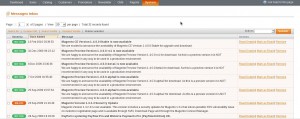我觉得我对 Magento 的理解与日俱增(哈,这不是废话)。
今天更新以前写的一段代码,有关在 block 里多次调用同一个 child block,但 child block 在每次调用时出现不同的内容,比如 product list block 去调用每个产品的 product block。Magento default theme 对此的处理方式跟我设想的不同,它把整个 product list block 就写成一个 block,没有 child block。在产品表现比较复杂的时候,特别是不同类的产品使用不同表现的时候,混写在一个 block 里代码就很乱,我想用 product list block 套用 product block 的方法去理清代码。
这里涉及四个要点:
1. 如果用 getChildHtml(‘product_block_name’),Magento 默认 block 只被调用一次,在 product list 循环里多次调用 getChildHtml(‘product_block_name’),结果所有产品显示的都是第一个产品。这是因为 Magento 缓存了 getChildHtml 返回值。如果要求每次都不用缓存值,必须使用 $useCache = false。$useCache 是 getChildHtml 的第二个可选参数,默认为 true,所以 getChildHtml(‘product_block_name’) 每次都得到了相同的结果;getChildHtml(‘product_block_name’, false) 就可以得到想要的不同结果。
2. 既然说到缓存 $useCache,请分清这不是 block html cache。前者只是一个变量 cache,存储在 block class 的属性里;后者是 php code cache,存储在 files/apc/memcached, etc.
3. Block 和 child block 之间怎么传递变量?亦即 product block 需要知道当前计算的哪个产品。很久以前我只会用 Mage::registry,于是每次在 product list block 里注册一个当前产品,然后调用 product block,在 product block 再取出注册值。我当时就不满意这种方案,我总觉得没有必要在全局注册一个变量来解决此类问题,但当时水平有限,想不到其他办法。现在有了:在 product list block 里使用
getChild('product_block_name’)->setProduct($product)->toHtml();
在 product block 写一个 setProduct() 方法:
public function setProduct($product) {
$this->_product = $product;
return $this;
}
请注意 block 不同于 model,没有 magic method 可以用,所以必须老老实实写一个对应的setProduct() 方法。
4. 如果用 getChild,就不用担心返回值被缓存,因为 getChild 不同于 getChildHtml,根本就不缓存返回值。
